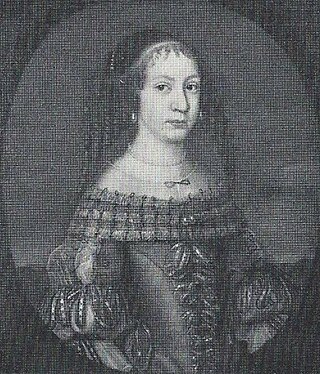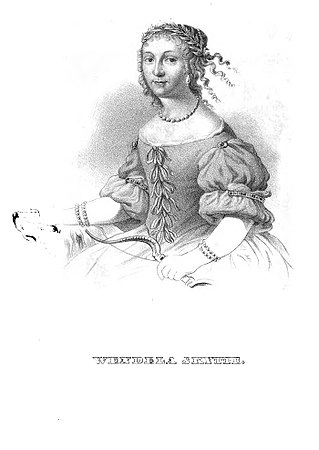
Laurentius PetriNericius was a Swedish clergyman and the first Evangelical Lutheran Archbishop of Sweden. He and his brother Olaus Petri are, together with the King Gustav Vasa, regarded as the main Lutheran reformers of Sweden. They are commemorated by the Evangelical Lutheran Church in America on 19 April.

Brita Christina Hagberg, née Nilsdotter, alias Petter Hagberg, was a woman who served as a soldier in the Swedish army during the Russo-Swedish War (1788–1790). She is one of two confirmed women to have been decorated for bravery in battle in Sweden before women were allowed into the military in the 20th century.

Lea Fredrika Ahlborn was a Swedish artist and medallist. She was a member of the Royal Swedish Academy of Arts and the first woman to be appointed royal printmaker. The position of royal printmaker was counted as a public office, and thereby made her the first female official or civil servant in Sweden.

Sofia Adolfina Adlersparre was a Swedish painter from the Adlersparre family.

Anna Åkerhielm or Åkerhjelm, née Anna Agriconia, was a Swedish writer, in languages including Latin, and traveller. She was the first woman in Sweden to have been ennobled for her own actions (1691).
Dorothea of Schleswig-Holstein-Sonderburg-Beck, known also as Dorothea von Holstein-Beck and Dorothea von Ziedewitz,, was a German princess of the House of Oldenburg and by marriage Margravine of Brandenburg-Bayreuth-Kulmbach.

Vendela Skytte was a Swedish noblewoman, salonist and writer, poet and Lady of Letters. During her lifetime, she became an ideal and role model for a learned female scholar.
Anna Sofia Ramström (1738–1786) was a kammarfru of the Queen of Sweden, Sophie Magdalena of Denmark. She was known for her involvement in the famous affair of the consummation of the marriage between the royal couple.

Nancy Fredrika Augusta Edberg, was a Swedish swimmer, swimming instructor and bath house manager director. She was the first Swedish woman in these fields. Edberg was a pioneer in making the art of swimming and ice skating accepted for women in Sweden
Fredrika Eleonora von Düben was a Swedish dilettante painter and embroidery artist
Josefina (Josephine) Deland, was a Swedish feminist, writer and French teacher. She founded Svenska lärarinnors pensionsförening, where she served as chairperson from its foundation in 1855 to 1859.
Ebba Månsdotter Lilliehöök of Kolbäck, was a Swedish noble, landlord and county administrator, Countess of Raseborg, Baroness of Gräfsnäs and lady of Käggleholm.
Martha Eriksdotter was the alleged daughter of Erik X, King of Sweden, flourishing in the first half of the 13th century. However, knowledge about her is derived from a genealogy added to a 15th-century copy of the Erikskrönikan. This genealogy may have been part of the ambition of Charles VIII of Sweden to prove his right to the throne by presenting a more impressive family background. The existence of Martha Eriksdotter and her marriage have therefore been doubted by some modern Swedish historians, who think she was just made up by Charles or his chancellery. Nevertheless, a few historians have maintained that her position cannot be entirely explained as a forgery.

Johanna Maria Hedén, née Bowall was a Swedish midwife, Feldsher, apothecary, and barber. She is the first known licensed female feldsher in Sweden and as such the first known formally educated and trained female surgeon in Sweden.
Magdalena Elisabeth de Ram van Hagedoorn, was a Swedish politically active salon-holder during the Age of Liberty.
Anna Ehrenström, née Gråberg, was a Swedish poet.
Ebba Maria De la Gardie (1657–1697) was a Swedish poet and singer.
Johanna Juliana Josefa Lohm née Pechlin von Löwenbach was a Swedish Baroness and educator. She was the founder and principal of a Girls' School in Stockholm which was active for about fifty years, until her death, and long counted as the most fashionable of its kind during the reign of Gustav III of Sweden.
Anna Andersdotter, was a Swedish noble, married to the Jöran Persson, the adviser of King Eric XIV of Sweden.
Lucretia Johansdotter Gyllenhielm (1561–1585), was the illegitimate daughter of John III of Sweden and Karin Hansdotter. She was reportedly the favorite of her father.







